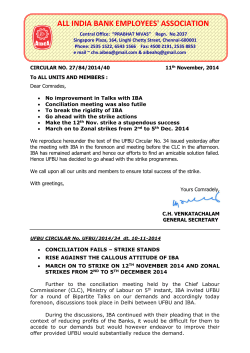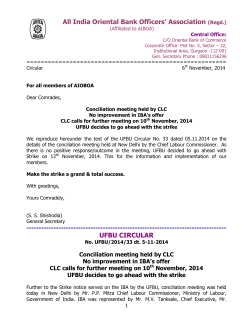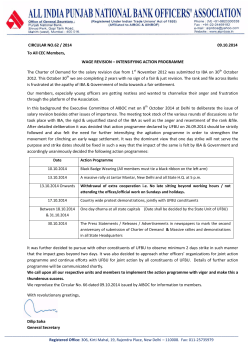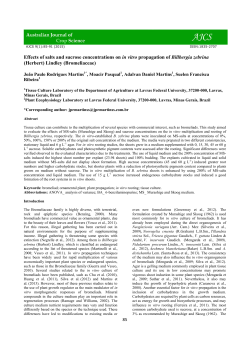
Cultivar “JUMBO”
Australian Journal of Industry Research SCIE Journals In Vitro Micropropagation of Blackberry (Rubus fruticosus.) Cultivar “JUMBO” Şeyma ARIKAN, Muzaffer İPEK, Ahmet EŞİTKEN University of Selçuk, Faculty of Agriculture, Horticulture Department-KONYA Abstract The objectives of the present study were to achieve improved techniques in in vitro propagation and to determine a better substrate for blackberry. After sterilization, explants were placed into MS medium supplemented with 1 mg/l GA3 in shoot initiation. 15 days after that, explants were cultured in Murashige and Skoog (MS) medium supplemented with different concentrations and combinations of 6-Benzylamino purine (BA), α-Napthalene acetic acid (NAA) and Indol acetic acid (IAA) in shoot proliferation stage. The developed upon transfer to rooting on the MS medium containing Indole butyric acid (IBA) at 0.25, 0.50 and 1.0 mg/l. Results indicated that the best multiplication of shoots was obtained with 2.0 mg/l BA + 0.5mg/l IAA concentration. Rooting was successfully achieved with 100% rooted plants in 1.0 mg/l IBA. Introduction Blackberry Rubus fruticosus (Tourn.) L. subgenus Eubatus are found in temperate zones around the world (McPheeters et al., 1988). Rubus species belong to the Rosaceae family. Blackberries are some of the most consumed berries in the world. While a large amount of fruit is sold in the fresh market, most blackberries are first processed into either individually quick frozen (IQF) fruit, puree, or juice that in turn are used as ingredients in processed products such as preservers, jam, jelly, baked goods, dried products, ice cream and yogurt (Hall, 1990). Blackberries are a rich source of anthocyanins and other polyphenolic antioxidants (Siriwoharn et al., 2004). Blackberry is commercially propagated by the classical methods of vegetative propagation, i.e. by hardwood and softwood cuttings, by layering and bush division. However, successful application of these methods of vegetative propagation is limited to certain extent. Although tissue-culturing blackberry is more expensive than conventional vegetative propagation methods, problems with disease May be considered more important than cost considerations (Caldwell, 1984). In vitro propagation through the development of axillary buds eliminates the seasonal limitations encountered with these methods and needs a small quantity of starting material, the in vitro plants propagated in this way in many species have proved to be healthy and true to type (Shen et al., 1990). Micropropagation of blackberries was studied by many researchers (Bobrowski et al., 1996; Erig and Schuch 2005; Gajdosova et al. 2006, Minas and Neocleous 2007; Ruzic and Lazic, 2006). For multiplication, several variants of Murashige & Skoog (Murashige and Skoog, 1962) medium were used, supplemented with growth regulators (BAP, IBA and GA3) and, for rooting, variants of MS medium containing IBA. The experiment were carried out to determine the best micropropagation media for then "Jumbo". Material and Method Blackberry shoots of “Jumbo” cultivar was utilized, coming from to shoot tip culture and kept in vitro. Initial explants were with 1.0 cm length and contained axillary buds were placed in MS (Murashige and Skoog, 1962) medium supplemented with 1 mg/l GA3 and 3% sucrose (w/v) and agar (0.7% ;w/v ). The pH of the media was adjusted to 5.8 after the media were autoclaved at 121 ºC and 1.5 atm for 20 min. Two weeks after initiation, the shoots were transferred to proliferation medium supplemented with different combination of BA (0, 1.0 and 2.0 mg/l), NAA (0, 0.25 and 0.50 mg/l), IAA (0, 0.25 and 0.50 mg/l). Each PGR combinations had 10 magenta boxes that has nine plantlets and contains 50ml solidified media, each of magenta box regard as a replicates, Cultures were maintained for 4 weeks (as long term salt stress) at the growth room (25±2°C) under a 16 hour photoperiod fluorescent light. Sub-culturing was done at regular intervals off our weeks up to 12 weeks (three subcultures). Number of shoots per explant after each subculture was noted. For rooting, shoots (1,5- 2cm in height) were transferred to rooting media which has three concentrations of IBA (0, Australian Society for Commerce Industry & Engineering www.scie.org.au 1 Australian Journal of Industry Research SCIE Journals 0.25, 0.50 and 1.0 mg/l). Then average number of shoot, rooting percentage, number of roots and length of roots per rooted shoot were recorded in during micropropagation stages. Data were statistically analyzed using the Duncan‟s multiple range test. Results and Discussion The table-1 shows that BA- IAA combinations has better results than only BA and BA- NAA combinations on proliferation stages. The highest shoot proliferation for “Jumbo” cultivar was in the 2.0 mg/l BA and 0.5 mg/l IAA (10,9 shoot/explant). Similar results in blackberry and pear were obtained by Pasqual et al. (1991) and Leite et al. (1993) respectively. Furthermore, Jafari Najaf-Abadi and Hamidoghli (2009) reported that the greatest number of shoots was obtained MS medium containing 2.0 mg/1 BA and 0.5 or 1 mg/1 GA3. In contrast to Jafari Najaf-Abadi and Hamidoghli (2009), Bobrowski et al. (1996) reported that GA3 was not effective on multiplication rate. The study of Villa et al. (2005) shows that the highest numbers of shoot were produced by WPM basal media containing 1.0 mg/1 BA. Table 1. Effect of BA, NAA and IAA combinations on average number of shoot Media Avarage Number of Shoot Control 1,59 h 1.0 mg/l BA 6,03 c 2.0 mg/l BA 4,40 e 1.0 mg/l BA+0.25 mg/l NAA 2,25 g 2.0 mg/l BA+0.25 mg/l NAA 1,18 i 1.0 mg/l BA+0.50 mg/l NAA 2,51 g 2.0 mg/l BA+0.50 mg/l NAA 3,85 f 1.0 mg/l BA+0.25 mg/l IAA 8,44 b 2.0 mg/l BA+0.25 mg/l IAA 5,44 d 1.0 mg/l BA+0.50 mg/l IAA 3,81 f 2.0 mg/l BA+0.50 mg/l IAA 10,90 a There was a statistical difference among IBA levels (0.25, 0.50 and 1.0 mg/l). All IBA levels had successfully rooting of shoots but a concentration of the best rooting was obtained from 1.0 mg/l IBA (100%). The highest number of roots and length of roots was in the 1.0 mg/l IBA level (Table-2.). James et al. (1980) reported that IBA stimulate rooting of red raspberry explants, just as study of Gonzalez et al., (2000) shows that medium containing IBA increased rooting percentage in blackberry. Also Bobrowski et al., (1996) obtained 100% rooting in blackberry cultivars (cv. Ebano, Tupi and Guarany). However, Fernandez et al. (1991), used a more complex medium (MS + 8.9 µM BA + 0.5 µM IBA + 0.29 µM GA 3) for micropropagation of blackberry cultivar "Navaho” and obtained 90% rooting. Table-2. Effect of different IBA levels on rooting Media Rooting rate (%) Number roots of Length (cm) Kontrol 16.66 d 2.33 c 1.33 c 0.25 mg/l IBA 43.33 c 3.67 bc 2.17 bc 0.50 mg/l IBA 76.66 b 4.67 ab 3.17 b 1.0 mg/l IBA 100.00 a 5.67 a 4.50 a of roots Australian Society for Commerce Industry & Engineering www.scie.org.au 2 Australian Journal of Industry Research SCIE Journals References Bobrowski, V.L, Mello-Farias, P.C., Peters J.A., 1996. Micropropagation of blackberries (Rubus sp.) cultivars, Rev. Bras. De Agrociencia, 2(1):17-20. Erig, A.C., Schuch, M.W., 2005. Tipo de luz na multiplicacao in vitro de framboeseira (Rubus idaeus L.) Batum. Rev. Bras. Frutic., Jaboticabal 27(3): 488-490. Fernandez, G.E., Clark, J., 1991. In vitro propagation of the erect thornless "Navaho" blackberry. HortScience, 26(9): 1219. Gajdosova, A., Ostrolucka, M.G., Libiakova, G,. Odruskova, E., Simala, D., 2006. Microclonal Propagation of Vaccinium sp. and Rubus sp. and detection of genetic variability of culture in vitro, Journal of Fruit and Ornamental Plant Research, 14 (1):103-119. Gonzalez, M.V. Lopez, M., Valdes, A.E., Ordas, R.J., 2000. Micropropagation of three berry fruit species using nodal segments from field-grown plants. Ann. appl. Biol. 137:073-078. Printed in Great Britain Jafari Najaf-Abadi, A, Hamidoghli, Y., 2009. Micropropagation of thornless trailing blackberry (Rubus sp.) by axillary bud explants. Australian Journal of Crop Science. 3(4):191-194. James, D.J., Knight, V.H., Thurbon, I.J., 1980. Micropropagation of Red Raspberry and the influence of phloroglucinol. Scientia Horticulturae12: 313-319. Leite, D.L., Peters, J.A., Nakasu, B.H., 1993. Micropropagação de pereira (Pyrus spp.) cultivar Carrick. Rev. Bras. Fisiologia, 14(1): 149-154. Minas, G.J., Neocleous D., 2007. A Protocol for Rapid Clonal Propagation in vitro of Primocane-Fruiting Red Raspberry Cultivars. Miscellaneous Reports 95, Agricultural Research Institute, Lefkosia, Cyprus, May, issued by the Press and Information Office, Lefkosia Murashige, T., Skoog, F. 1962. A revised medium for rapid growth and bio assays with tobacco tissue cultures. Physiol. Plant. 15:473-497. Pasqual, M., Peixoto, P.H.P., Santos, J.C., Pinto, J.E.B.P., 1991. Propagação in vitro da amora-preta (Rubus sp.) cv. Ebano: uso de reguladores de crescimento. Ciênc. e Prát. Lavras, 15(3): 282-286. Ruzic, D., Lazic, T., 2006. Micropropagation as Means of Rapid Multiplication of Newly Developed Blackberry and Black Currant Cultivars. Agriculturae Conspectus Scientificus, 71 (4): 149-153 Shen, X.H., Wan, J.Z., Luo, W.Y., 1990. Propagation in vitro of Chinese Gooseberry (Actinidia chinensis) through the development of axillary buds. Scientia Horticulturae 42: 45-54. Villa, F., Araujo, A.G., Salles Pio, L.A., Pasqual, M., 2005. In vitro multiplication of blackberry (Rubus sp.) Ebano in different MS medium concentrations and BAP. Ciênc agrotec, Lavras 29(3): 582-589. Australian Society for Commerce Industry & Engineering www.scie.org.au 3
© Copyright 2025












